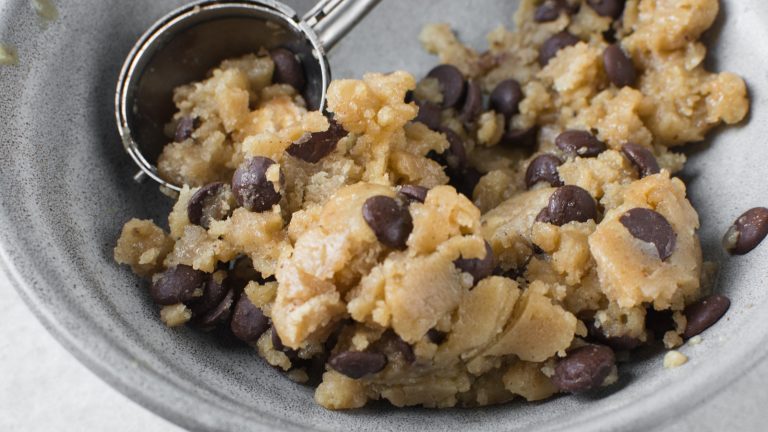We may receive a commission on purchases made from links.
As a professional pastry chef, I’m always brainstorming new ways to add a creative twist to my desserts. Often, when I’m in a recipe development rut, I find myself leaning toward the natural flavor of fruits to enhance my confectionery creations. Whether it’s adding a splash of ube extract into a New York-style cheesecake recipe or folding diced apricots into my sponge cake, incorporating fruit into baked goods will always do three things: enhance the flavor, add visual appeal, and improve the texture.
Though it’s fairly common to use fruits such as bananas, strawberries, pears, apples, and blueberries in baked goods, these ordinary, everyday options can feel a little dull. If you want to be the best baker out there, you’ve got to be creative and experiment in the kitchen with ingredients you might not be familiar with. Use this list as your guide to explore 14 unexpected fruits you should incorporate more into your baking routine! Head into your kitchen, turn on the oven, put on an apron, and start creating some deliciously sweet treats with these unique, tasty fruits!
Mango
Mangoes offer a sweet, tropical flavor with hints of pineapple, peach, and orange, complemented by a mild floral note. Ripe mangoes are appreciated for their delightful, juicy, sticky, and creamy texture. Although mangoes are available throughout the year, their prime season typically spans from late May to early September, making it an ideal period for baking with them.
To incorporate mangoes into baked goods, puree them into a smooth consistency and use them as a wet ingredient. Keep in mind that mangoes are naturally sweet, so you may need to decrease the amount of granulated sugar in your recipe. This mango puree can be blended into cake batter, resulting in a moist and flavorful cake. Embrace the exotic tastes by pairing them with a coconut and lime buttercream frosting. You can also use the puree for a tart filling or a quick bread like a mango pound cake or a mango scone! Mangoes can enhance the taste of any baked treat, whether it’s a cake or muffin, making it fruitier, juicier, and far more flavorful.
Pandan
You might recognize pandan from the vibrant green hue that it gives dishes or from its distinctive grassy flavor. Pandan is a tropical plant sometimes referred to as screwpine, and it’s highly valued for its fragrant, long, and narrow leaves. Alongside the grassy flavor, it has subtle notes of vanilla, coconut, and almond. It has an intense, nutty, floral aroma that makes any baked good smell divine. While pandan isn’t technically a fruit, that doesn’t mean it shouldn’t be used in baking.
Pandan is extremely popular throughout Southeast Asian cuisine and especially in desserts. It’s often used to flavor the delectable coconut jam from Singapore called kaya and as the main flavor component for kue dadar gulung, an Indonesian rolled pancake dessert. Asian American bakeries across the United States have recently been featuring pandan-infused desserts more frequently. At some bakeries, you can find pandan chiffon cake, cheesecake, cookies, and even ice cream! It’s slowly taking the throne of vanilla beans in sweet treats, and you should definitely give it a try the next time you’re baking.
You can find it in Asian grocery stores in the produce section, being sold in its natural form as leaves; however, to make the baking easier, definitely pick up either pandan extract or powder. When baking, use it as you would vanilla extract. Add it to whatever batter or dough you’re making. Just be sure it’s fully combined so you don’t wind up with any green streaks in your baked goods.
Boysenberries
If you’ve ever been to Knott’s Berry Farm in Orange County, California, you have probably come across these delectable berries! They are a quintessential symbol of the amusement park and have become mainstream due to its bakery’s delicious boysenberry pies and preserves. However, you don’t have to travel all the way to SoCal to get your hands on boysenberry desserts. You can just use them in your baking at home!
For those of you who don’t know, boysenberries have an exceptionally sweet and tangy flavor. They are a great alternative to mainstream berries like blueberries and strawberries, showcasing the intensity of blackberries and the floral character of raspberries. They are well-known for their deep purple coloring, juicy texture, and plump size. While these berries are terrific eaten directly off the vine, they are even better in sweet treats. Of course, you can use them as a filling for pies and tarts, although if you’re looking to bake something different, try folding them into your muffin batter or scone dough. Boysenberries’ juicy and plump texture is also perfect for baking an incredibly moist cake. Top it with an almond-flavored buttercream to complement the sweet and tart flavor, and you’ve got the perfect dessert!
Ube
Ube, where to begin? Well, for starters, it’s not actually a fruit. The Filipino yam is technically a vegetable. However, don’t let that deter you — the unique, nutty, vanilla-like flavor is superb in baked goods. It’s well-known for its vivid deep purple color and coconut-like aroma. Occasionally, people will confuse it with the purple Japanese sweet potato from Okinawa, although the two vegetables are completely different. Ube-flavored desserts are very popular in Filipino cuisine, and just like pandan, ube has been enthusiastically embraced by Asian American bakeries across the nation.
You can typically find ube at most Asian grocery stores, either sold whole or in the form of an extract. For baking purposes, it’s best to use ube extract for a more concentrated flavor and deeper purple color. Ube extract can be used across a wide variety of desserts, from cakes to cheesecakes to frosting and ice cream. Next time you want to switch things up in your baking, try using ube extract. The beautiful purple and delectable flavor will have you completely enchanted!
Coconut
Looking to bake a dessert with a tropical flair? If so, you should consider using coconut! Coconut has a unique, nutty, slightly sweet flavor with a caramelized aroma when baked. The tropical fruit adds a level of rich, buttery, and creamy flavor to desserts that you can’t find in any other fruit.
There are loads of baked goods you can make with coconut, like this easy 4-ingredient coconut cake or maybe some coconut baked donuts. However, there are a few desserts featuring coconut that never go out of style, like the German chocolate cake, macaroons, and, of course, coconut cream pie. You can find coconut at most standard grocery stores, either sold fresh or made into shreds, flakes, milk, or flour. Coconut flakes taste amazing when lightly toasted in the oven. Be creative and use them as a garnish on a layered cake or sprinkle it over sweet sticky rice. Coconut flour can be a great alternative to all-purpose flour, especially for those who are gluten-free. Just make adjustments to the recipe accordingly if you’re opting out of using all-purpose flour.
Grapes
While it might be a bit bizarre to use grapes in baking, it’s actually fairly common in the Italian region of Tuscany. During the autumn grape harvest season, bakeries across the region are stocked with a sweetened flatbread called schiacciata con l’uva. The tasty flatbread is studded with red grapes and fennel seeds, creating a delicious and sticky dessert that’s practically dripping with the sweet juice of grapes. You can also find torta bertolina made popular in the Italian town of Crema. This cake is a prime example of how grapes can be used in baking — everything from the sweet, tangy flavor coming from the cooked grapes to the perfectly moist interior is utterly divine.
Besides these Italian specialties, there are numerous other ways you can use grapes in your baking. You can fold them into your muffin batters or bread doughs or use as a tart filling. It’s best to use grapes when they are in their peak season from late summer to autumn. If you want to keep it simple to showcase the flavor of the grapes, just roast them in the oven and ladle them over freshly made biscuits, topped with clotted cream. Whether it be red, purple, or green grapes, they’re excellent in baking and should definitely be on your radar the next time you’re crafting a sweet treat.
Figs
Another great fruit you should be using in baking more is figs! Just like apples and oranges, there are hundreds of fig varieties that vary in color and size; however, regarding flavor, they all taste relatively like a mix of fresh berries, honey, and dates. This unique fruit typically has a round and plump shape with a pulpy, soft texture with tiny, crunchy seeds.
Look for figs to start popping up in farmers’ markets and grocery stores around the end of May and early June. That’s the perfect indication to start baking with them. Fresh figs’ beautiful shape and jammy-like texture make them excellent in tarts and galettes. There’s simply nothing more elegant than figs artfully arranged on top of a pastry cream tart.
If you want to keep it easy, just chop some up and add to a basic cake or muffin batter. Figs pair excellently with toasted nuts like walnuts and almonds, so adding them as a garnish in whatever baked good you’re using them in is a smart idea. It’s common in professional pastry kitchens to make them into a jam and fill croissants, danishes, muffins, and hand pies. You can also incorporate the jam into frostings for cakes or even use it as a layer in tiered cakes.
Passion fruit
While it may be difficult to find, passion fruit should definitely be on your roster for fruits to incorporate into your baked goods. Passion fruits have a sweet and tart taste with a subtle floral flavor. Some people describe them as having a citrusy flavor with notes of kiwi and pineapple. You can easily recognize a passion fruit from its dark purple exterior and round, golf ball shape. The interior has a pulpy texture that’s filled with crunchy, tiny black seeds.
Its unique flavor profile makes it a versatile and beloved option across a plethora of sweet treats. It’s a classic topping for pavlovas; the tartness pairs extremely well with the crunchy meringue and whipped cream. If pavlovas aren’t really your thing, you might try them in a tart or use them to create a creamy passion fruit custard filling that is a taste of paradise.
Oddly enough, passion fruit’s fruity, slightly acidic flavor provides a delightful contrast to the rich sweetness of chocolate. Try making a passion fruit mousse and let the flavors speak for themselves.
Pineapple
Pineapple works exceptionally well with baked goods, and the sweet, tangy flavor and aroma will transport you to a tropical island! You can use pineapple in a multitude of ways, whether it’s a flavor addition, moisture enhancer, sweetener, or textural component when baking. One of the most notable pineapple desserts is the delectable pineapple upside-down cake, featuring a caramelized sugar and pineapple base topped with a golden cake. This cake is super popular in Hawaii, and you should give it a whirl if you’re looking to bake with pineapple. You can use canned pineapple to make the easiest dump cake of your life. And if you’ve only got access to pineapple juice, you can make some lovely Hawaiian bread rolls.
Pineapple is sold in-store either fresh or packaged in cans. Don’t let the canned pineapple deter you — the extra sweetness and moisture make it an excellent option to use in your baking, especially when pineapples aren’t in season. Plus, it’s a bit more budget friendly compared to fresh pineapple.
Plums
Quit using peaches in desserts and try another cousin in the stone fruit family like plums. There are over 2,000 varieties of plums in the world, so there’s no lack of them, that’s for sure! The most common variety you’ll likely find at grocery stores and farmers’ markets year-round is the elephant heart plum. It has a reddish-purple skin color with a bright red flesh. Once ripe, plums become deliciously sweet and extremely juicy. Slice them in half and place them on top of your cake for a delectable dessert.
Don’t toss your overripe, squishy, and bruised plums in the trash. You can easily puree them into a smooth paste that works as a layer for tiered cakes or a filling for croissants or hand pies. Similar to passion fruit, plums have a tart flavor that pairs exceptionally well with chocolate desserts. Replace the ganache in this delicate, decadent chocolate macarons recipe with a plum jam to give a vibrant contrast to the rich chocolate flavor.
Tomatoes
Yes, tomatoes are a fruit, and you seriously have got to try using them in your baking. Tomatoes have a wide range of flavors that can be used in both savory and sweet recipes. They are well-known for having a slightly acidic flavor, although they do have an underlying sweet flavor. You should bake with them during their peak season in summer, when the ripe tomatoes are incredibly juicy, and the sweet, sugary flavor is at an all-time high.
If you want a creative dessert for a dinner party, you can slow-roast them in the oven with a bit of granulated sugar, puree them into a smooth sauce, and use that to garnish a sweet panna cotta. The naturally sweet flavor of the roasted tomatoes and creaminess from the panna cotta is a superb and innovative combination.
You can also just chop them up and directly add them to bread dough. Whether it’s a sourdough, pullman loaf, or focaccia, tomatoes are fantastic in bread dough. They’ll add a delicious, earthy flavor and a good amount of moisture, ensuring your loaf of bread will be fluffy, soft, and tender.
Persimmons
Persimmons are an underrated fruit, and many people don’t know what to do with them — and the answer is to use them in your baked goods. These unique fruits have a sweet, honey-like flavor. People often describe them as having a tropical vanilla-like taste with a scent of roses and ripe apricots.
You might be surprised to know that persimmons are technically a type of berry, even though they are commonly mistaken for a tomato due to their similar appearance. The fruit has a light orange color, and as it ripens, the skin transitions into a deeper orange hue. Most grocery stores will typically sell them unripe and hard as a rock; however, over time, the skin and flesh soften into a luscious, jelly-like texture.
The two most common varieties are the fuyu from Japan and the hachiya from China. The fuyu has a plump tomato-like shape and tart flavor, whereas the hachiya is acorn-shaped with incredible sweetness. Both of these varieties are excellent to use in baking. Their soft texture can easily be pureed into a pulp and incorporated into whatever you’re wanting to bake. Whether it be a persimmon-flavored cake or as a moistening agent for your sourdough bread, the fruit has an absolutely delicious flavor that will shine through in anything you make with it.
Apricots
Besides being an excellent fruit to pair with cottage cheese, apricots are fantastic in baked goods! This scrumptious fruit has a sweet, tangy flavor, often being described as a cross between a peach and a plum. Apricots have a delicious honey-like taste with underlying tartness. As they ripen, their flesh turns extremely juicy and soft. Apricots are super versatile when it comes to baking; you can use them as filling for pies and tarts or simply make them into jam for cookies and scones. During peak apricot season in France, the fruit is often added to a baked fruit-filled custard dessert called clafoutis. The apricots supply the dessert with a delectable tartness that perfectly complements the sweet and sugary flavor from the custard.
If you’ve picked up a bag of apricots from a farmers’ market and you want to highlight the natural flavors, just oven roast them until slightly caramelized and top with a dollop of whipped cream. Bonus points if you serve them with a slice of buttered toasted brioche on the side.
Mulberries
Looking for a unique berry to use in your baked goods? Mulberries are the perfect option! Oddly, the berry slightly tastes like a fig with the floral flavor of blackberries and red grapes. Fresh off the vine, these berries can also have a subtle, earthy taste. Once fully ripened, they are at the perfect level of tartness and sweetness. Mulberries come in three different varieties: white, red, and the most commonly used in pastry production, black. Each of them tastes relatively the same; however, the black mulberries have a more intense sweet flavor and firmer texture, making them well-suited for sweet treats.
Just like any type of berry, mulberries are fantastic as a pie or tart filling. If you want to take your baked goods up a notch, you should turn the mulberries into a jam. You can use this delicious jam to fill pastries, muffins, or scones, or simply spread it over a slice of homemade sourdough bread. When adding them into batters for cakes or muffins for even distribution, always be sure to lightly toss them in a tablespoon or two of all-purpose flour before adding them into your wet ingredients. This will prevent any sinkage that might occur during the baking process.





